Resource Capacity Planning (RCP) is often mistakenly viewed as a mere scheduling of workforce and tools. In reality, it is the foundational resource management practice that converts a company’s strategic vision into reality.
In a market defined by talent shortages, rising project complexity, and aggressive deadlines, resource capacity planning enables companies to predict resource demand and capacity ahead of the curve.
It provides a clear understanding of who is available, for how long, and with what skills. This crucial foresight helps organizations forward plan projects, ensure successful delivery, and improve client satisfaction.
Therefore, resource capacity planning has become the ultimate tool for balancing project commitments with business health. More importantly, it is the single source of truth for answering the most critical question in project management: “Can we actually do this?”
This blog sheds light on the fundamentals of resource capacity planning and its role in helping businesses stay future-ready amid market volatility.
What is Resource Capacity Planning? A Complete Definition
Resource capacity planning is the continuous strategic process of assessing and aligning resource capacity (people, equipment, capital, etc.) against forecasted demand for the projects in the pipeline. By proactively identifying and closing short- and long-term resource and skill gaps, this process ensures optimal resource allocation, prevents overallocation, and maximizes operational efficiency, project success, and strategic alignment.
Now that we understand what resource capacity planning is, let us explore its top benefits.
What are the Top Business Benefits of Resource Capacity Planning?
According to a McKinsey report, “90% of leaders consider capacity planning a pressing to-do that needs addressing now or soon.”
This urgency reflects why resource capacity planning is essential. It helps businesses plan upcoming projects while future-proofing the workforce against market volatility.
Here are some of the key benefits it offers:
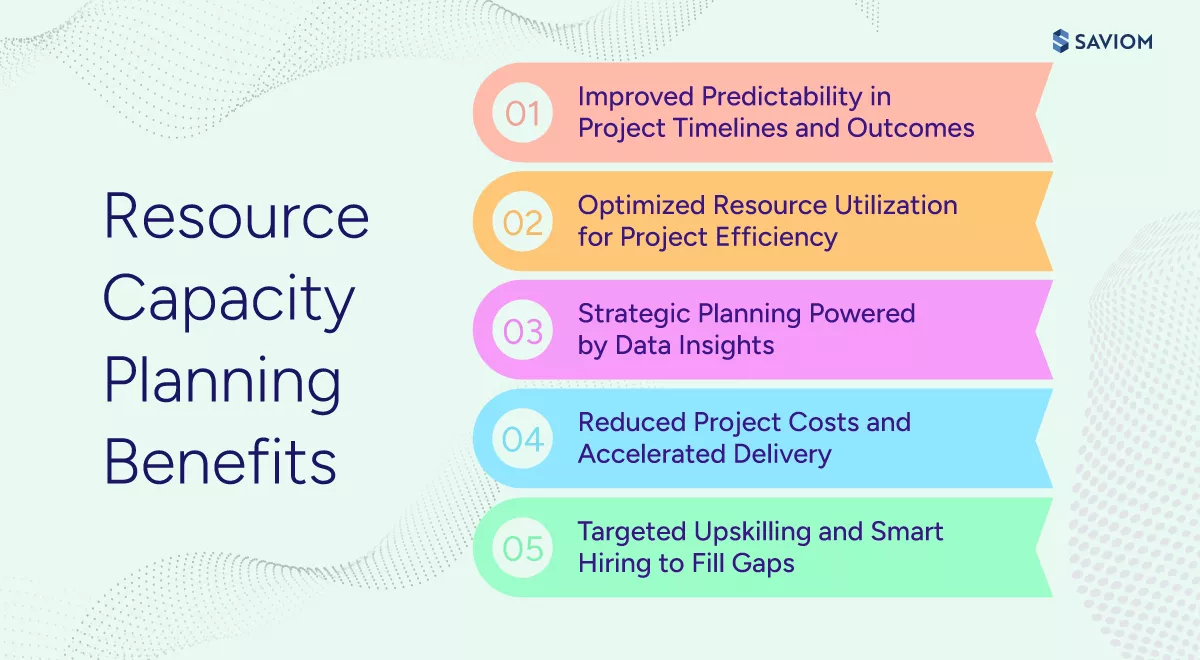
Improved Predictability in Project Timelines and Outcomes
With a clear understanding of whether the right capacity and capabilities exist to support planned initiatives, project managers can commit to realistic timelines and reduce the chances of missed deadlines. Moreover, with fewer last-minute allocation and firefighting scenarios, project execution becomes consistent, ensuring high-quality outcomes.
Optimized Resource Utilization for Project Efficiency
Optimization means more than just keeping resources busy; it means ensuring they are working on high-value tasks aligned with their skill sets. Effective capacity management minimizes “bench time” (idle resources) and prevents burnout from over-allocation, resulting in better employee engagement and higher output quality.
Learn more about resource utilization with this blog: What is Resource Utilization? How to Measure and Optimize Efficiently?
Strategic Planning Powered by Data Insights
A robust capacity plan shifts resource conversations from reactive arguments about who is available today to proactive, data-driven decisions for tomorrow. Thus, with key insights into future skill shortages or surpluses, leaders can make strategic interventions such as redeploying resources, upskilling existing staff, or strategic talent acquisition to meet current and future demand adequately.
Reduced Project Costs and Accelerated Delivery
Resource capacity planning enables firms to prevent costly delays, minimize rework caused by rushed execution, and reduce the need for expensive, last-minute contractor hires. Accelerated delivery means faster time-to-market and quicker realization of project benefits.
Targeted Upskilling and Smart Hiring to Fill Gaps
As per The Future of Jobs Report, “Upskilling is among the top three priorities across economies and geographies at all income levels.”
This statistic underscores the critical importance of workforce readiness for long-term success. With a practical resource capacity planning framework, organizations can gain early visibility into future skill demands. This allows leaders to prioritize cost-effective upskilling of current staff or a phased, strategic hiring plan, rather than reactive emergency recruitment.
Know more: Infographic: 6 Effective Strategies to Build a Robust Capacity Planning Model
In the following section, let us go through the key components of resource capacity planning.
Key Components: Understanding Resource Demand, Capacity, and Gap Analysis
Understanding these six core concepts is essential for building an accurate and functional capacity model.
| Component | Definition | Strategic Importance |
|---|---|---|
| Skill Inventory | A detailed, standardized database that catalogs every resource’s skill, certifications, and proficiency levels. | Ensure resources are allocated based on the right competencies and minimize mismatches. |
| Resource Capacity | Refers to the total amount of work a resource can complete over a specified period of time. | Sets realistic expectations for resource availability and prevents workload imbalances. |
| Project Demand | The total effort required to deliver all current and future projects, measured in hours or FTE. | Helps leadership prioritize and sequence projects based on resource availability, not assumptions. |
| Capacity vs. Demand Gap Analysis | Identifies gaps between available capacity and future demand. | Enables timely intervention such as rescheduling, upskilling, or hiring. |
| Utilization Forecasting | Projects resource usage over a future period (e.g., 6 months) to predict overutilization or bench time. | Ensures balanced workloads and improves profitability by keeping utilization at an optimal level across the portfolio. |
| Scenario Modeling | Testing the impact of “What-If” changes (e.g., accelerating Project X) on the resource plan without committing to them. | Supports smarter decision-making by selecting the most feasible and cost-effective risk mitigation strategy. |
Here is the formula to calculate resource capacity and demand, as well as capacity vs. demand gap:
Resource Capacity:
Resource Demand:
Capacity vs. Demand Gap:
- A positive gap indicates excess capacity and bench time
- Negative gap indicates skill or capacity shortages
The Role of Resource Capacity Planning in Project and Portfolio Management
Resource capacity planning aligns resource availability with project demand to ensure projects are completed on time and within budget, and that talent is utilized efficiently. Here are key roles and functions:
- Allocating the Right Resources to the Right Project: Resource capacity planning ensures resources are allocated based on capability and strategic priority, guaranteeing project quality and execution speed.
- Aligning Resource Utilization with Strategic Goal: At the portfolio level, resource capacity planning ensures that critical resources are dedicated primarily to projects that deliver the highest client or strategic value and ROI.
- Balancing Capacity Across the Portfolio: Planning resource capacity in advance, preventing resource hoarding in one project or department while others struggle, promoting resource sharing, and ensuring an equitable workload.
- Proactive Risk Management and Bottleneck Identification: Capacity plans highlight future bottlenecks such as skill shortages or resource unavailability well in advance, allowing managers to mitigate risks preemptively.
- Cost Forecasting and Budget Adherence: An effective resource capacity plan improves project and portfolio budget accuracy by directly linking planned resource hours to labor rates. This enables leaders to make smarter investment decisions.
Looking to dig deeper into resource capacity planning? Check out these recommended reads:
- What is Capacity Management? Types, Importance, KPIs, & Best Practices
- Project Portfolio Management- How Resource Capacity Planning Can Be a Game-Changer
Next, let’s take a look at different types of resource capacity planning strategies.
Types of Resource Capacity Planning Strategies: Lead, Lag, and Match Approaches
An organization’s resource capacity planning strategy dictates its approach to resource supply relative to demand. Here are the primary strategies to consider.
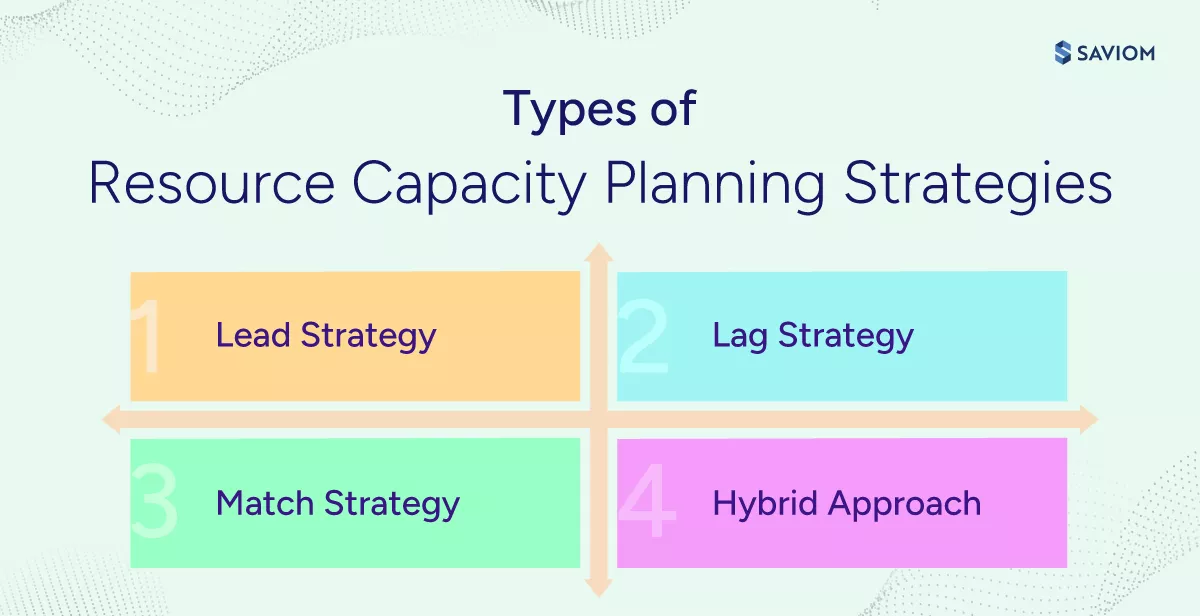
The Lead Strategy: Proactively Hiring for Future Demand
In the lead strategy, enterprises added capacity before the actual demand materialized. For instance, hiring 10 engineers because you expect a 50% growth next year.
- Risk: Higher idle time (bench costs) if the forecasted demand does not materialize.
- Best For: High-growth companies and critical, highly specialized skills.
The Lag Strategy: Reacting to Resource Overload
In this case, capacity is added only after demand exceeds current capacity and a shortage is experienced.
- Risk: High risk of project delays, employee burnout, and lost revenue opportunities.
- Best For: Conservative, cost-conscious organizations or easily outsourced, non-core tasks.
The Match Strategy: Finding the Optimal Balance Point
In the match strategy, capacity is increased in phased increments based on accurate demand forecasts, maintaining a steady balance between supply and demand.
- Risk: Requires precise resource forecasting to avoid oscillating between lead (overcapacity) or lag (shortage) patterns.
- Best For: Most mature organizations seeking a balance between cost control and delivery speed.
The Hybrid Approach: Combining Lead, Lag, and Match
In practice, organizations often use a hybrid approach, hiring ahead for specialized skills, and adding general support only when demand increases.
Want to explain it further? Check this blog out: 5 Effective Steps to Measure Resource Capacity and Demand
Next, let’s dive into the steps of the resource capacity planning process.
The 7-Step Resource Capacity Planning Process (A Detailed Walkthrough)
The resource capacity planning process is an ongoing and data-driven endeavor that helps organizations stay aligned with changing business demands. By following these seven practical steps, you can ensure your plan is realistic, proactive, and delivers desired results.
- Step 1. Assess Current Resource Capacity and Capabilities – Calculate productive capacity and assess workforce proficiency through an updated skill inventory.
- Step 2. Capture and Aggregate Project Demand – Collect estimated effort (demand) for all projects and sum it up over the planning horizon (e.g., 12 months).
- Step 3. Perform a Capacity vs. Demand Gap Analysis – Visualize the discrepancy between supply and demand to identify future bottlenecks clearly.
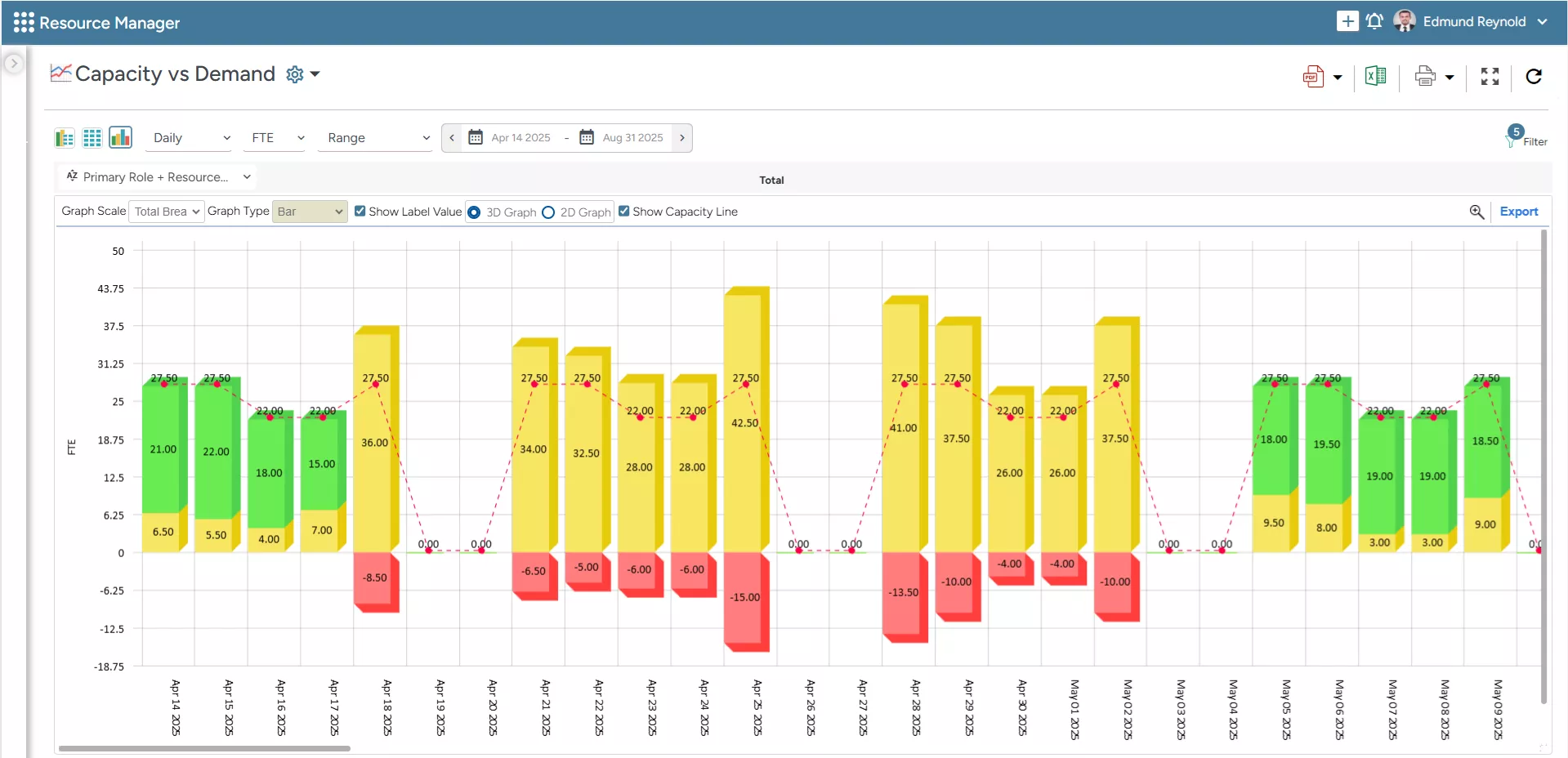 SAVIOM’s Capacity vs. Demand Graph enables managers to quickly spot resource shortages and excesses and take timely action to balance supply and demand.
SAVIOM’s Capacity vs. Demand Graph enables managers to quickly spot resource shortages and excesses and take timely action to balance supply and demand.
- Step 4. Analyze Scenarios to Resolve the Gap – Use “what-if” models to test potential solutions such as delaying projects, upskilling staff, outsourcing specialized work, or hiring staff.
- Step 5. Finalize Gap Resolution Strategies and Get Approval – Document the optimal plan and secure executive stakeholder commitment.
- Step 6. Implement the Plan and Track Utilization – The approved plan drives allocation. Continuously monitor actual utilization against the forecasted plan.
- Step 7. Monitor, Review, and Optimize the Process – Schedule regular reviews (monthly/quarterly) to monitor adherence and refine resource forecasting accuracy.
Discover more: Beat Market Volatility With Efficient Resource Capacity Planning
Now that we’ve covered the step-by-step resource capacity planning process, let’s explore how these principles apply in Agile and Scrum environments.
Resource Capacity Planning in Agile and Scrum Environments
Capacity planning is not just for traditional Waterfall projects; it is essential for scaling Agile and Scrum teams effectively. It helps them align delivery capacity with business priorities and maintain a sustainable pace of work.
- Aligning Agile Capacity Planning with Strategic Goal: Resource capacity planning aligns long-term portfolio strategy (quarterly or yearly) with the tactical work of the development team (sprint-based). It ensures that teams stay focused on the highest-priority features that deliver maximum business value.
- Sprint-Based Capacity Planning: In Scrum, capacity is calculated on a sprint-by-sprint basis by factoring in holidays, time off, and the team’s historical velocity (how many story points they typically complete).
- Balancing Velocity and Resource Availability: A good capacity plan ensures that the workload (story points pulled into the sprint) never exceeds the team’s velocity, promoting a sustainable and consistent pace.
- Accounting for Interruptions and Shared Service Resources: Agile capacity planning must factor in buffer capacity, time set aside to handle inevitable interruptions, bug fixes, and demands from shared services, protecting the team’s focus time.
Curious? Read on: The Fundamentals of Agile Capacity Planning: A Guide
Common Resource Capacity Planning Challenges and Practical Solutions
Despite robust capacity planning processes, many organizations encounter recurring challenges that hinder effective execution. The table below highlights key problem areas and practical solutions to address them.
| Challenge | Description | Practical Solution |
|---|---|---|
| Inaccurate Resource Estimation and Scope Creep | Resource estimation is often based on assumptions rather than historical data. Frequent scope changes without proper control also distort capacity forecasts. | Mandate standardized estimation techniques (e.g., T-shirt sizing) and require formal governance (change requests) before allowing changes that affect committed resource requirements. |
| Outdated and Inaccurate Skill Inventory | Businesses often lack an up-to-date record of employee skills, certifications, and proficiency levels, leading to ineffective capability assessment. | Implement a centralized platform that integrates with HR systems and requires managerial validation of skill proficiency during regular review cycles. |
| Failing to Forecast Resource Utilization Ahead of Time | Organizations often fail to anticipate future utilization levels. This lack of foresight results in uneven workloads and reduced productivity. | Institutionalize a rolling, forward-looking utilization forecast review (e.g., monthly). This forces decision-makers to focus on future gaps rather than historical data. |
| Imbalanced Workload Across Teams and Resource Hoarding | Often, high-performing employees are overloaded with critical assignments. At the same time, certain departments tend to hoard skilled resources, even when demand elsewhere is higher. | Establish an executive-level resource governance committee that has the authority to approve and enforce cross-functional resource sharing. |
| Complexity of Allocating Resources in Matrixed Teams | In matrix organizations, employees report to multiple managers, causing unclear ownership and competing priorities. Conflicts arise when multiple managers vie for the same skilled resources. | Use a centralized resource management platform that provides a clear, single view of a resource’s total allocation and requires sign-off from both the functional manager and the project manager. |
Explore this blog to learn more: Top 9 Capacity Planning Challenges & Ways to Overcome Them
Let’s now explore proven best practices to strengthen organizations’ overall capacity planning maturity.
What are the Key Best Practices for Effective Resource Capacity Planning?
The following resource capacity planning best practices distinguish mature, high-performing organizations from those still relying on manual spreadsheets. Let’s take a look:
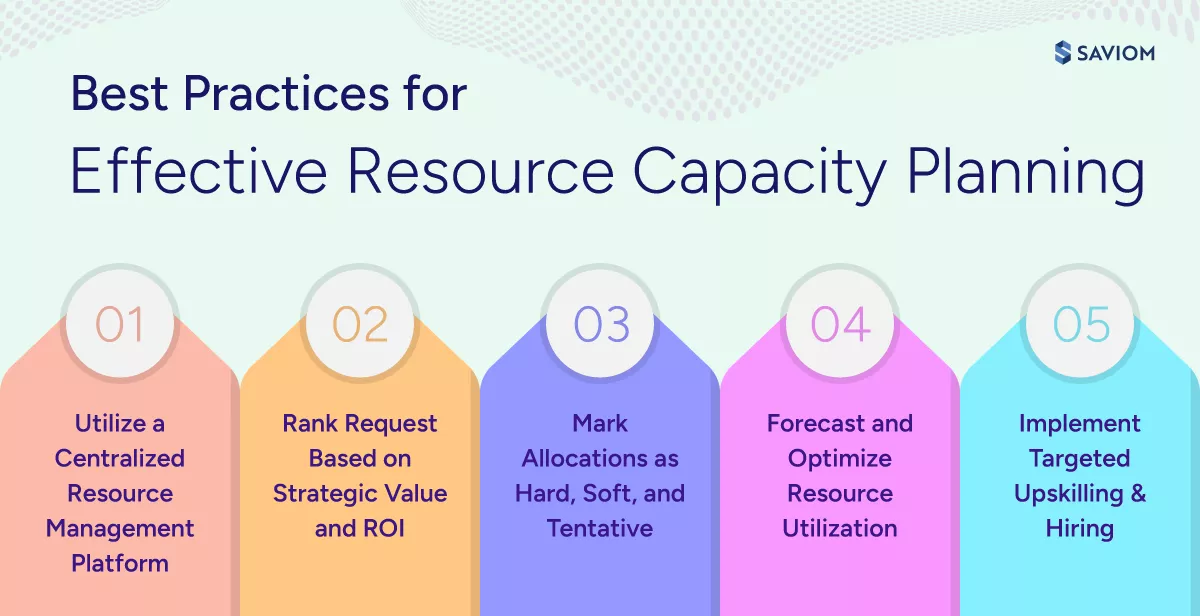
- Implement a Dedicated Centralized Resource Management Platform: Replace spreadsheets with a centralized system that manages complex resource data, runs “what-if” scenarios, and serves as a single source of truth for faster decision-making.
- Prioritize Resource Request Based on Strategic Value and ROI: Do not commit resources on a first-come, first-served basis. Every resource request should be prioritized based on the project’s estimated strategic value, compliance necessity, and calculated ROI.
- Differentiate Hard, Soft, and Tentative Resource Allocations: Define commitment levels —hard allocation (committed), soft allocation (planned), and tentative allocation (prospective) — to enhance planning accuracy and transparency.
- Forecast and Optimize Resource Utilization Early On: Define healthy utilization benchmarks (typically 75–85% for knowledge workers) and leverage capacity forecasts to proactively optimize utilization before a resource hits 100% (burnout) or drops below 60% (bench time).
- Implement Targeted Upskilling and Data-Driven Hiring: Use forecasted skill gaps to upskill internal staff (cross-training) before initiating external, often more expensive, data-driven hiring.
Explore more best practices with this article: 15 Best Practices for Next Generation Resource Management
Having understood resource capacity planning best practices, let us explore key KPIs that help quantify performance, identify gaps, and drive continuous improvement.
Tracking Success: Key Resource Capacity Planning KPIs and Metrics
Tracking the right KPIs helps organizations evaluate and improve the effectiveness of their capacity planning process. Let’s take a look at the key metrics.
Top Resource Utilization and Efficiency Metrics
- Productive Capacity: The percentage of a team’s total work hours dedicated to value-driving project tasks.
- Target Utilization Rate: The actual hours worked on projects compared to the organization’s ideal utilization goal.
Forecasting and Estimation Accuracy Metrics
- Forecast Variance: The difference between the resources planned for a project and the resources the project actually consumed. A lower variance indicates higher forecasting accuracy.
- Estimate Accuracy Rate: The rate at which initial project estimates fall within an acceptable deviation range (e.g., ±10%) of the final actual effort.
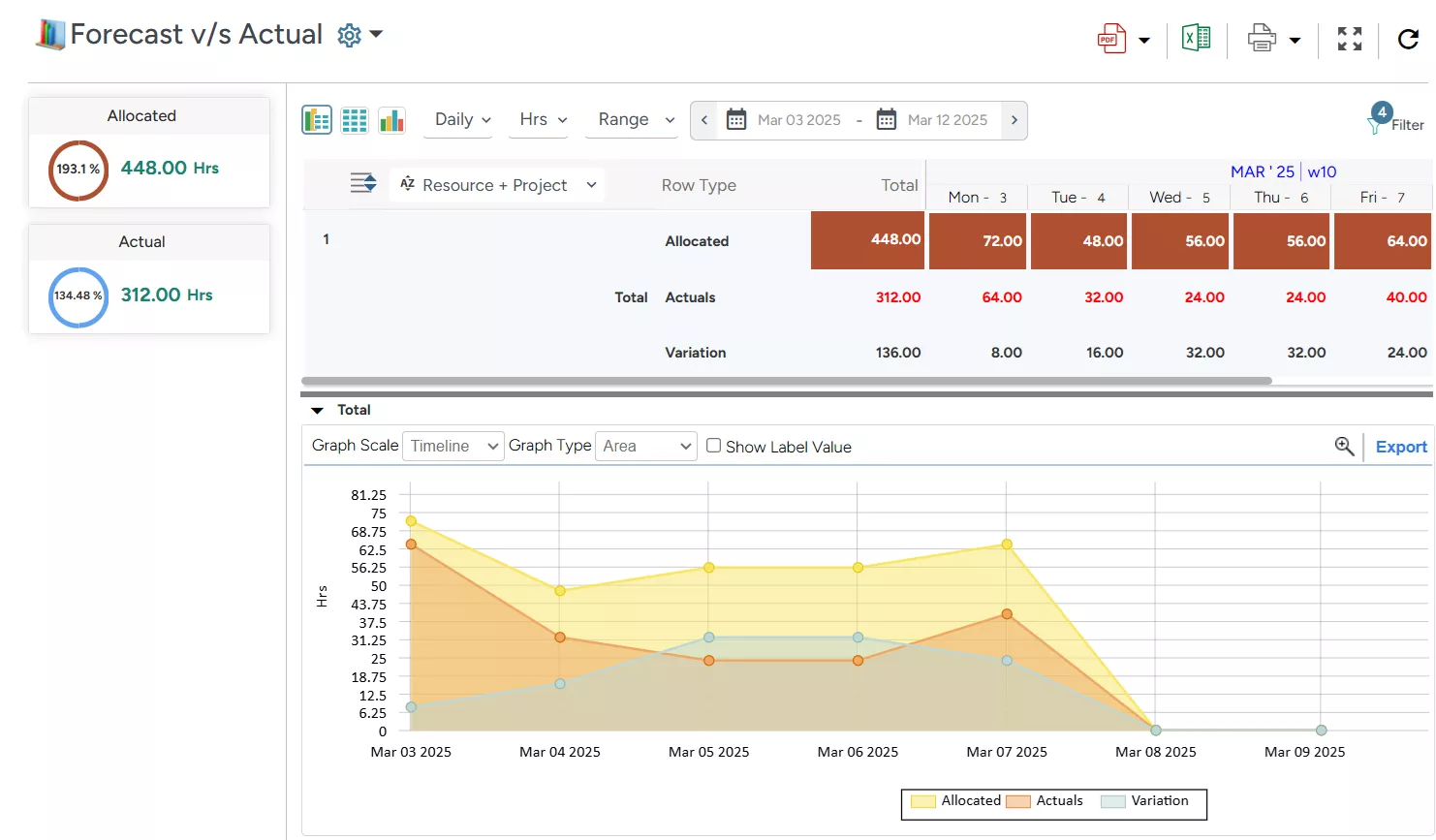 SAVIOM’s Forecast vs. Actual Report highlights estimated vs. actual time spent on tasks, helping managers identify variances and take corrective action.
SAVIOM’s Forecast vs. Actual Report highlights estimated vs. actual time spent on tasks, helping managers identify variances and take corrective action.
Strategic Alignment and ROI Metrics
- Portfolio Value Density: Measures the dollar value of business benefits delivered per resource unit (FTE).
- Resource Alignment Score: The percentage of total productive capacity allocated to top-tier strategic projects.
Resource Health Metrics: Bench Time, Burnout, and Attrition
- Over-Allocation Rate: The percentage of resources consistently allocated beyond 100% capacity for a sustained period (leading to burnout risk).
- Involuntary Attrition Rate: The percentage of staff turnover resulting from non-voluntary reasons such as burnout, performance issues, or layoffs.
Find out more: Resource Management KPIs: 15 Metrics to Ensure Resource Efficiency and Project Success
Now, let’s examine how capacity planning varies across key industries.
Industry-Specific Capacity Planning: Examples, Practices, and Unique Challenges
Since capacity planning challenges vary by sector, organizations must tailor their approach to align with each industry’s unique workflows, demand trends, and resource requirements.
| Industry | Unique Challenge | Core Focus |
|---|---|---|
| Professional Services & Consulting | Optimizing Billable Utilization. A resource on the bench is lost revenue. | Maximize billable utilization and strictly manage non-billable time. |
| AEC (Architecture, Engineering, Construction) | Capacity Planning Project Phases and Milestones. Resources (people and equipment) are required sequentially across long, distinct phases. | Align capacity to firm project milestones. Track certified personnel and critical equipment availability. |
| Accounting and Auditing | Managing Seasonal Fluctuation, i.e., extreme peaks (tax season) and deep troughs in demand. | Use scenario modeling for flexible staffing, relying on contractors during peak times. |
| Healthcare and Pharma | Staff and Equipment Planning. Capacity is fixed by specialized, certified staff and high-cost equipment (e.g., MRI machines). | Critical Equipment Planning and meticulous Staff Certification tracking to ensure compliance. |
| Marketing & Creative Agencies | Handling scopes and client volatility. Client demands are vague, and scope changes are frequent. | Use soft allocation for pipeline work and implement strict scope definition rules to manage creative capacity. |
Learn how to create practical strategies with this article: 10 Key Capacity Building Strategies for Business Growth
In the following section, let us understand how modern resource capacity planning software helps firms anticipate demand, allocate resources efficiently, and maintain operational agility in a dynamic business environment.
Stay Future-Ready with Resource Capacity Planning Tool
Effective resource capacity planning is essential for improving project and business performance. That’s why organizations must choose robust resource capacity planning software to move beyond the limitations of traditional solutions. It offers advanced functionalities like:
- All-in-one resource planner with 360-degree visibility into project pipelines and resource schedules.
- Embedded capacity planner to forecast demand and address skill gaps.
- KPI forecaster for insights into availability, utilization, burnout, and skill gaps.
- What-if analysis to simulate scenarios and optimize resource plans.
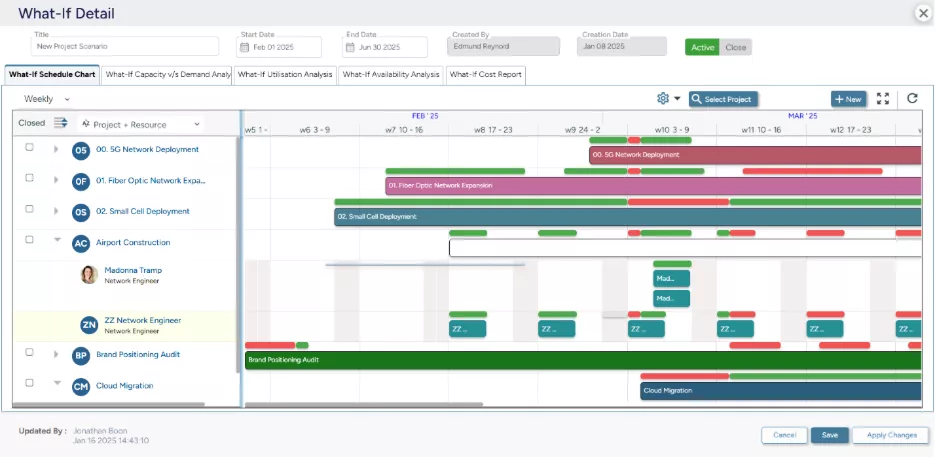 SAVIOM’s scenario modeling feature allows managers to create and test multiple workforce scenarios in a sandbox environment.
SAVIOM’s scenario modeling feature allows managers to create and test multiple workforce scenarios in a sandbox environment.
- Competency matrix to track and update resource skills to quickly identify and address gaps.
- Real-time BI reports like forecast vs. actual, project vacancy, and people-on-the-bench for granular insights and timely corrective actions.
- Intelligent matchmaker with filters to align resources to tasks.

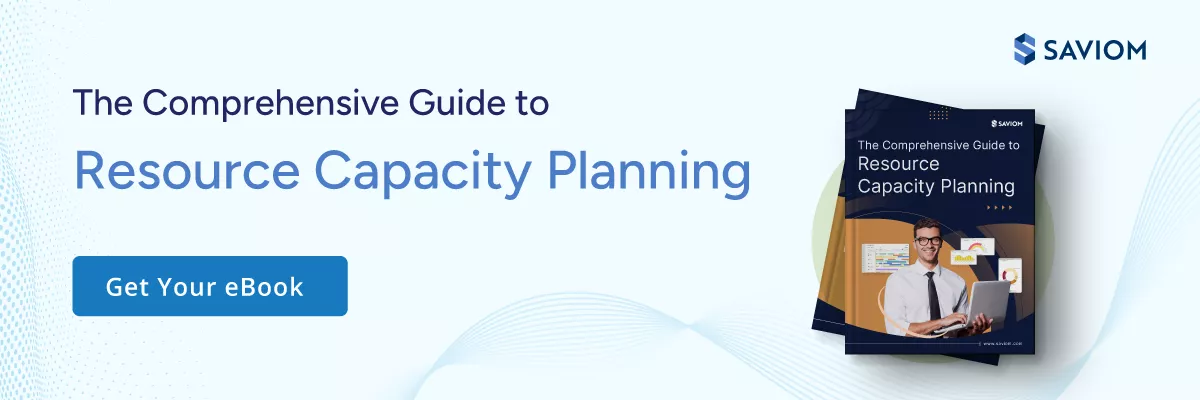


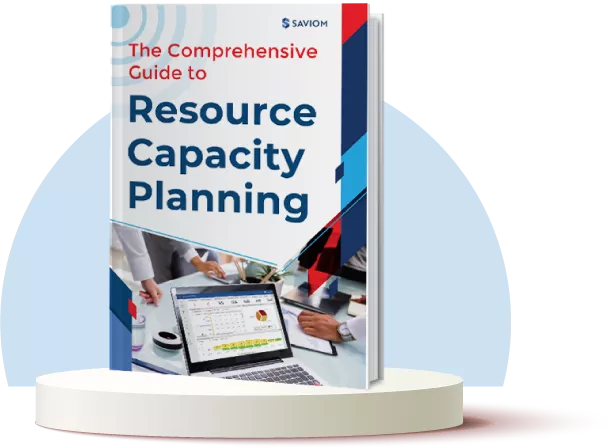



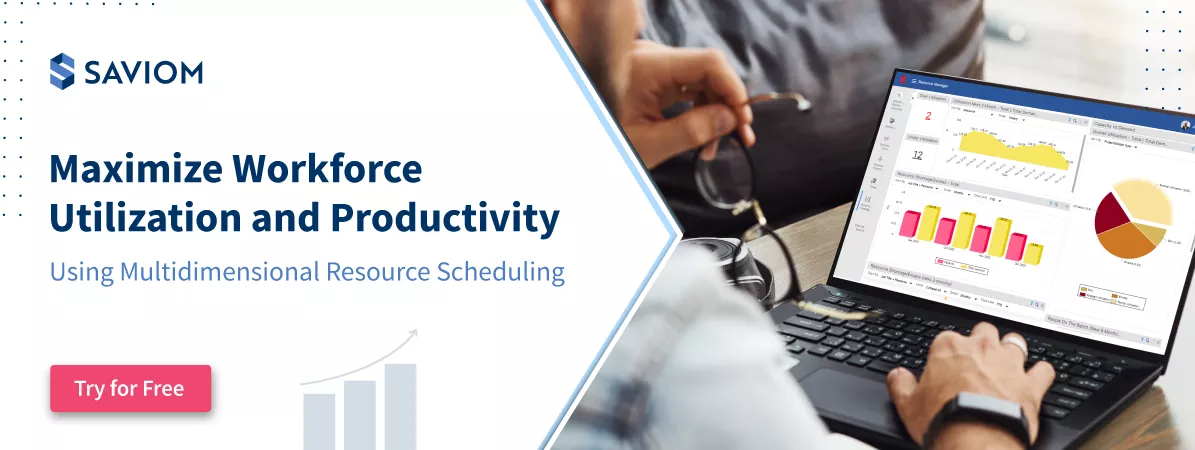



Leave a Reply